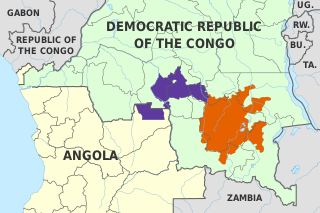Luba-Katanga, also known as Luba-Shaba and Kiluba (Luba-Katanga: Kiluba), is a Bantu language (Zone L) of Central Africa. It is spoken mostly in the south-east area of the Democratic Republic of the Congo by the Luba people.[3]
Kiluba is spoken in the area around Kabongo, Kamina, Luena, Lubudi, Malemba Nkulu, Mulongo, Kabalo and Kaniama, mostly in Katanga. Some 500 years ago or more, the Luba Kasai left Katanga and settled in the Kasai; since then, Luba Kasai (Chiluba) has evolved until it is no longer mutually intelligible with Luba Katanga.
Most Bantu languages are closer to Luba-Katanga rather than Luba-Kasai because the Luba-Kasai language is newer, while Luba-Katanga is older.
Luba-Katanga alphabet
Luba-Katanga has 22 letters, 5 vowels and 17 consonants.
Vowels: A E I O U
Consonants: B D F G H J K L M N P S T V W Y Z
Phonology
Vowels
A five vowel system with vowel length is present in Luba-Katanga:
| Front | Central | Back | |
|---|---|---|---|
| Close | i iː | u uː | |
| Mid | e eː | o oː | |
| Open | a aː |
Consonants
| Bilabial | Labio- dental |
Alveolar | Post-alv./ Palatal |
Velar | ||
|---|---|---|---|---|---|---|
| Nasal | m | n | ɲ | ŋ | ||
| Stop | voiceless | p | t | k | ||
| voiced | b | d | ɡ | |||
| vl. prenasal | ᵐp | ⁿt | ᵑk | |||
| vd. prenasal | ᵐb | ⁿd | ᵑɡ | |||
| Fricative | voiceless | (ɸ) | f | s | ʃ | |
| voiced | (β) | v | z | ʒ | ||
| vl. prenasal | ᶬf | ⁿs | ⁿʃ | |||
| vd. prenasal | ᶬv | ⁿz | ⁿʒ | |||
| Approximant | l | j | w | |||
- /p, b/ can have the allophones [ɸ, β] when in intervocalic positions or before a semivowel.[4]
Sample text
Sample text in Luba-Katanga- Pādi palembwe amba mwingidi wa “Tattannu, muledi wa Bukila bwa Munonga” —ko kunena’mba i enka Tatenai utelelwe ne mu mukanda wa mu Bible wa Ezela.
Translation
It identifies a witness to the transaction as a servant of “Tattannu, governor of Across-the-River” —the same Tattenai who appears in the Bible book of Ezra.
(Translation from Jehovah's Witnesses)
References
- ^ Kiluba at Ethnologue (17th ed., 2013)

- ^ Jouni Filip Maho, 2009. New Updated Guthrie List Online
- ^ Batibo, Herman (January 2005). Language Decline and Death in Africa. Multilingual Matters. p. 74. ISBN 1-85359-808-9.
- ^ Nkiko, Munya Rugero (1975). Esquisse grammaticale de la langue luba-shaba (parler de Kasongo Nyembo). Lubumbashi: Université Nationale du Zaïre.
- Samuel Phillips Verner (1899). Mukanda wa Chiluba. Spottiswoode. Retrieved 26 August 2012.

